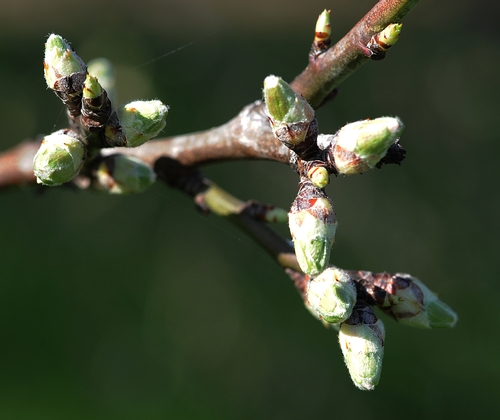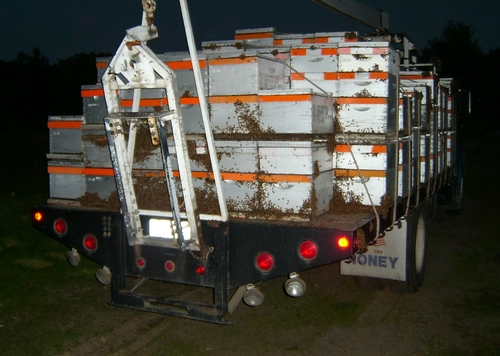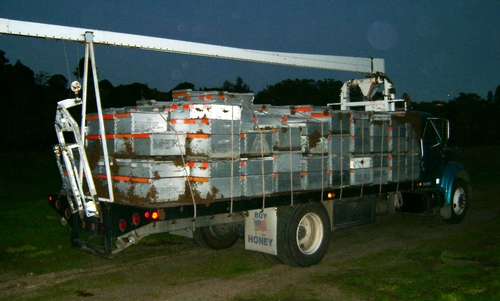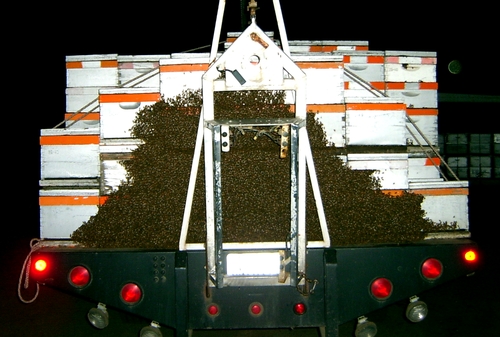- Author: Kathy Keatley Garvey
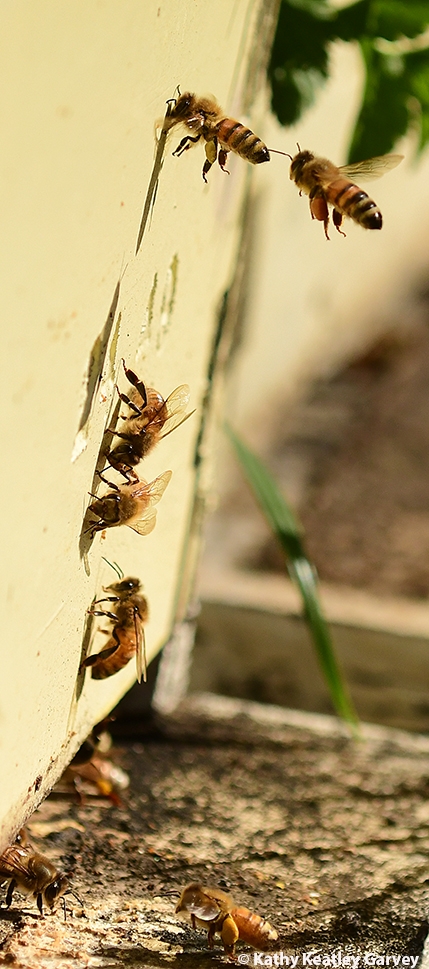
Of course, you go.
Almond pollination season is a delight to see and record. Almonds rank No. 2 among California's most valued agricultural commodities, right behind dairy products.
Sadly, glamour photographers often trespass on private property to take images of high fashion models in evening gowns and high heels, or to pose newly engaged couples and newlyweds. (One professional photographer even lists "40 poses for spring engagement photos in almond orchards.")
Apparently there's money to be made from the hard work of the farmers.
However, those of us born and raised on a farm appreciate the land, crops and farmers more than we do trespassing glamour photographers looking for a backdrop.
Almond pollination season ought to be about almond pollination.
Latest statistics from the U.S.Department of Agriculture's National Agricultural Statistics Services, show that "California's 2020 almond acreage at an estimated 1,600,000 acres, 5.3 percent higher than the 2019 acreage of 1,520,000. Of the total acreage for 2020, 1,250,000 acres were bearing, 5.9 percent above 2019, and 350,000 acres were non-bearing, up 2.9 percent from 2019. Preliminary bearing acreage for 2021 is estimated at 1,330,000 acres."
"Fresno, Kern, Stanislaus, Merced and Madera were the leading counties. These five counties accounted for 73% of the total bearing acreage."
Almond pollination season usually starts around Feb. 14 and ends around mid-March. Growers advocate two hives per acre. But since California doesn't have enough bees to pollinate the almonds, beekeepers truck their bees here from all over the United States. The Almond Board of California points out that "two-thirds of the nation's commercial honey bees hives converge in California."
This year almond growers and beekeepers faced frost ("cold snap"), rain, hail and a myriad of hive thefts. (In addition to trespassing photographers.)
Sadly, on our visit to an isolated Esparto almond orchard on Feb. 16, we not only saw the beginning of the almond pollination season, but the beginning of more work for the land owners--a discarded mattress, tossed potato chip bags, crumbled candy wrappers, broken beer bottles and other trash.
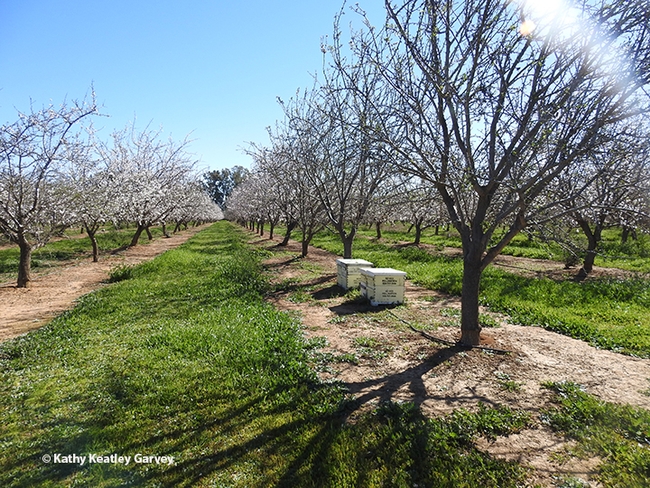
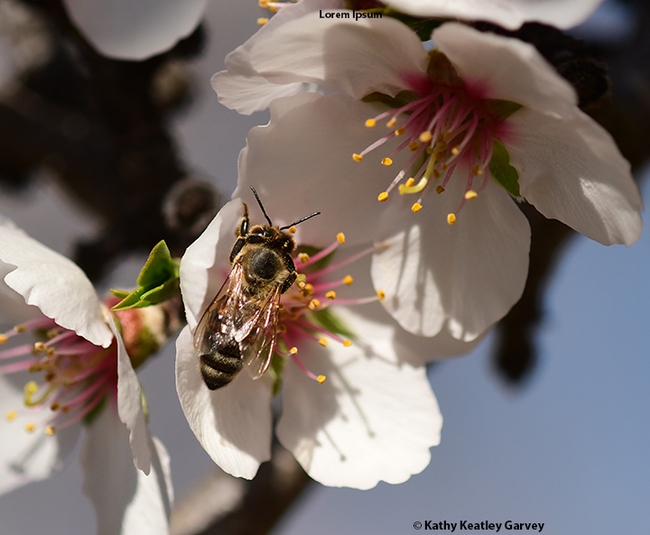
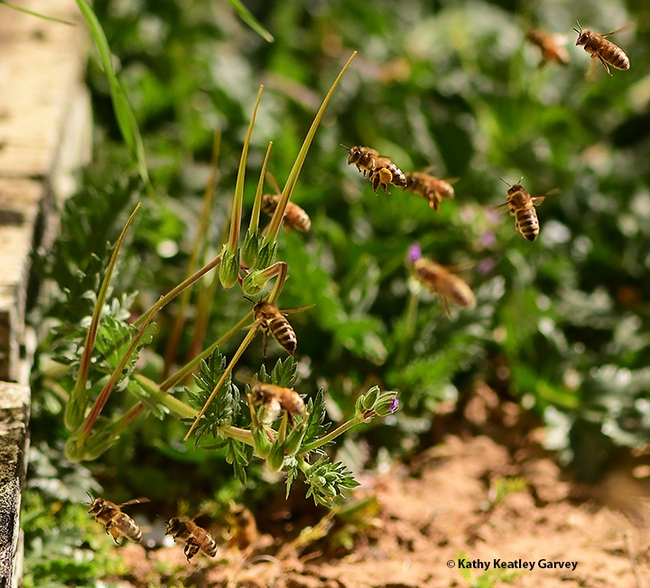
- Author: Kathy Keatley Garvey

Honey bee guru Eric Mussen, Extension apiculturist with the UC Davis Department of Entomology, said today that almond growers may not have enough bees to pollinate this year's crop of 800,000 acres.
“We need 1.6 million colonies, or two colonies per acre, and California has only about 500,000 colonies that can be used for that purpose,” he said. “We need to bring in a million more colonies, but due to the winter losses, we may not have enough bees.”
Those winter losses--still being tabulated--and the resulting fewer bees per hive could spell trouble for almond growers, he said.
The fact is 2012 was a bad year for bee nutrition. Honey production appears to be way down, maybe the worst ever in our nation's history. Nectar and pollen foraging are closely linked, Mussen says, and malnutrition is one of the stressors of colony collapse disorder (CCD), which since 2006 has decimated about a third of our nation's bees.
Bee scientists believe that CCD--characterized by adult bees abandoning the hive, leaving behind the queen, brood and food stores--is caused by multiple factors, including pests, parasites, pesticides, diseases, viruses, stress, and yes, malnutrition.
“Many, many colonies are not going to make it through the winter,” said Mussen, an apiculturist in the UC Davis Department of Entomology since 1976 (and who plans to retire in June of 2014). “We won’t have as large a bee population as in the past.”
Already brokers are getting calls from beekeepers saying “I can’t fulfill the contract. I’m going to be short.” Beekeepers charge the almond growers an average of $150 per hive.
The average almond orchard in California is in full bloom around Feb. 14, but some orchards bloom earlier or later, depending on the cultivar and the weather.
It remains to be seen what will happen in the almond orchards this year. Mussen says it may all work out well in the end as “bees pollinate almonds on a community basis. The strong colonies will make up for the weak colonies. The strong colonies will clean the orchard of pollen by early afternoon and then go down the street and grab food from nearby orchards.”
Almonds are California's biggest export. This year the National Agricultural Statistics Service is forecasting a record-breaking 2.10 billion meat pounds, valued at approximately $3 billion. California grows 80 percent of the global supply of almonds, and about 70 percent of California’s crop is marketed overseas.
No bees? No almonds.

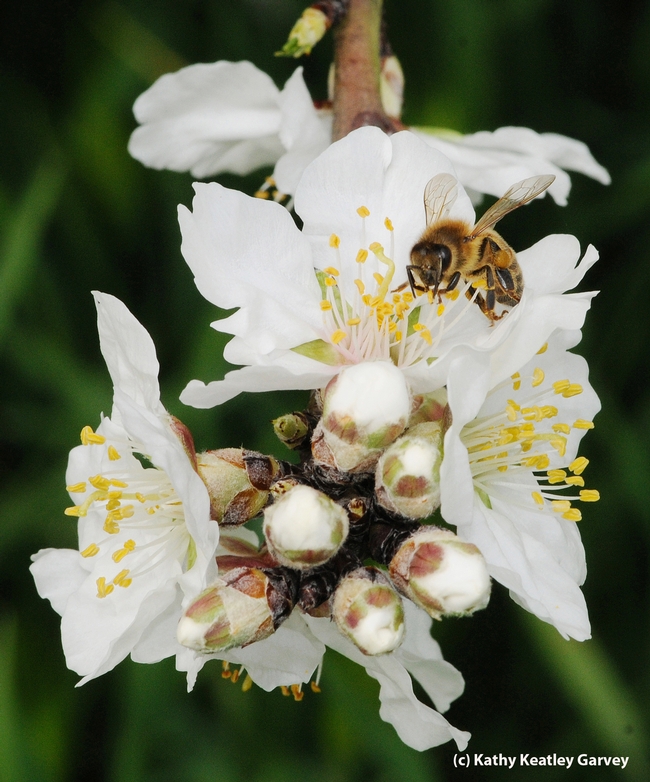
- Author: Kathy Keatley Garvey
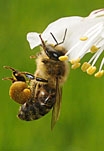
When Extension apiculturist Eric Mussen of the UC Davis Department of Entomology asked California beekeepers for photos of their bee trucks moving out at night to the almond orchards, his call did not go unanswered.
Bob Miller of Miller's Honeybees in Watsonville provided a series of photos.
But let's let him tell the story:
"These photos were taken February 2005. They (bees) had been doing very well and it was a warm evening. We had loaded these colonies near Monterey Bay, and were moving them to Braden Ranch almonds near Snelling.
"This load contained about 135 colonies, and had been given additional supers for honey production about 10 days prior and had pretty much filled them. This is usually not a normal happening at this time of the year. The bees, being warm and on a honey flow, needed to have some breathing room, so out they came. We unloaded them that evening after a three-hour trip. They had not cooled down at all."
Amazing photos. We're glad Bob Miller picked up his camera before heading out; his photos help tell the bee-almond pollination story.
This year's California almond crop is valued at $3.2 billion. NASS (National Agricultural Statistics Service, U. S. Department of Agriculture) forecasts 1.65 billion pounds this year, up 8.5 percent above last year's revised production of 1.41 billion.
However, this may be overstated by 50 million pounds, according to industry consensus.
Mark Jansen, president and CEO of Blue Diamond Growers, writes in the current edition of Almond Facts, that a predominantly wet harvest could "reduce the saleable product by another 20 to 50 million pounds, bringing the likely crop size to between 1.55 and 1.6 million pounds."
And, he writes, "With a consumption growth rate of 8 percent, our industry will need a 2011 crop of more than 1.75 billion pounds to sustain its current growth. As most regions in the world consume more almonds, and with developing nations desiring more protein in their diet plants, almonds are a perfect fit."
California currently has 750,000 acres of almonds in production, with each acre requiring two bee colonies. That's 1.2 million colonies needed to pollinate the almonds, according to honey bee guru Eric Mussen. Since California doesn't have that many colonies--the number is around 500,000--the remainder must come from beekeepers outside the state.
Early varieties of almonds are already blooming, but generally, Feb. 14--Valentine's Day--launches the pollination season for the commercial growers.
At the Harry H. Laidlaw Jr. Honey Bee Research Facility at UC Davis, my favorite almond tree--yes, everybody ought to have a favorite almond tree--is just about to burst into bloom.
The Laidlaw bees and other pollinators are currently foraging in the cape mallow, bush germander, roses and seaside daisies in the Haagen-Dazs Honey Bee Haven.
But they're checking out those almonds.
As are we all.
